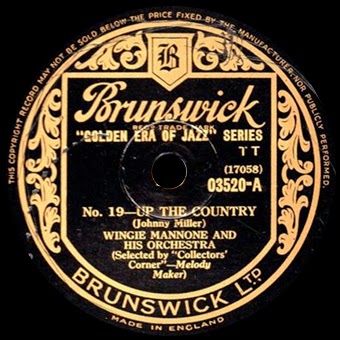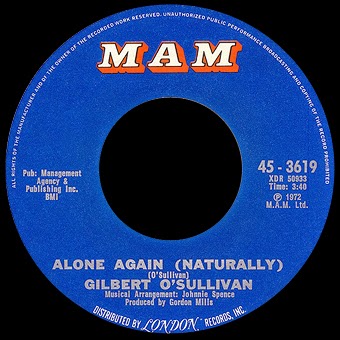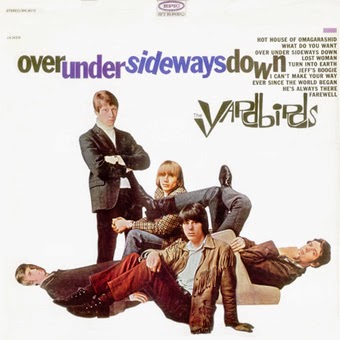Happy Thanksgiving and today’s selection is the reason I picked Vee-Jay Records as our fourth week label feature. “Thank You Girl,” which was originally titled “Thank You Little Girl,” was an effort for The Beatles to thank their female fans. They hoped that each of these young ladies would consider the song as being a personal message of gratitude. The recording featured John Lennon on double tracked lead vocals and Paul McCartney on the high harmony. Additionally, it was the first recording by group to feature double tracked vocals. The song took 13 takes to complete and features harmonica overdubs by John Lennon.

The Beatles’ “Thank You Girl” appeared as a flip side on not one, but two Vee-Jay single releases by The Beatles. When Capitol Records passed on The Beatles in 1963, the masters of their first album, “Please Please Me” in the UK, were leased to Chicago based Vee-Jay Records. Prior to Beatlemania hitting America by storm in 1964, Vee-Jay released two singles: “Please Please Me”/”Ask Me Why” and “From Me to You”/”Thank You Girl.” The latter was released in the US on May 6, 1963. Since The Beatles were yet an unknown commodity in North America, “From Me to You” only charted at #116.
Once the floodgates were opened with the #1 release of “I Want to Hold Your Hand” on Capitol,” Vee-Jay began ramping up their Beatles product and beat Capitol to the punch with the first American Beatles’ LP, “Introducing The Beatles,” on January 10, 1964. Capitol followed with “Meet the Beatles!” ten days later.
Although the album titles and covers were different, “Introducing The Beatles” and “Please Please Me” had much in common including track order. There was one major difference; the UK version had more songs. Like all of the UK releases through “Revolver,” “Please Please Me” was no exception, as it contained two additional cuts that were eliminated from the American release. “Please Please Me” and “Ask Me Why,” which had been previously issued in early 1963 as the first Beatles’ Vee-Jay single, were not on the initial release of the album.
As Vee-Jay was trying to quickly capitalize on the new found fame of The Beatles before their license expired, “Introducing The Beatles” was repacked several times. The first reissue replaced “Love Me Do” and “P.S. I Love You” with “Ask Me Why” and “Please Please Me.” This was due to a restraining order from Beechwood Music, Capitol’s publishing arm, who had not licensed these two songs yet in the US.
During 1964, Vee-Jay issued other albums featuring the material from “Introducing The Beatles.” These included “Jolly What! England's Greatest Recording Stars: The Beatles and Frank Ifield on Stage” (which was later repacked as “The Beatles and Frank Ifield on Stage”); “Songs, Pictures and Stories of the Fabulous Beatles”; “The Beatles vs the Four Seasons”; and an EP, “Souvenir of Their Visit to America.” The two versions of the Beatles/Frank Ifield album was misleading as all of the tracks were studio recordings – four by The Beatles and eight by Ifield.
Additionally, Vee-Jay flooded the market in 1964 with additional Beatles’ singles. These included the following:
- “Please Please Me”/“From Me to You,”
- “Ask Me Why”/“Anna” (promo only),
- “Twist and Shout”/“There’s A Place” (on Vee-Jay subsidiary Tollie Records),
- “Do You Want to Know a Secret”/“Thank You Girl,”
- “Love Me Do”/“P.S. I Love You” (on Vee-Jay subsidiary Tollie Records),
The second release of our feature tune was as the “B” side to “Do You Want to Know a Secret.” This single was released on March 23, 1964 and did quite well as a double sided hit. “Do You Want to Know a Secret” peaked at #2, while “Thank You Girl” made it to #35.
The record was certified gold for sales in excess of a million copies. Because Vee-Jay was overwhelmed in pressing Beatles’ records, numerous label variations exist for all of the releases. The one shown above is a Tollie yellow blank used for this particular issue. Black blanks, also used for Tollie releases, were used as well.
To make one last stab at sales before Vee-Jay’s license expired in October 1964, the label issued four Vee-Jay/Tollie singles on their subsidiary Oldies 45. “Do You Want to Know a Secret” and “Thank You Girl” were issued with the lowest catalog number of the four simultaneous releases.
True Stereo Version
While the Vee-Jay issues were either mono or rechanneled stereo, a true stereo version of “Thank You Girl” was issued by Capitol on “The Beatles’ Second Album,” which was released on April 10, 1964. In addition to being a true stereo mix, this version of “Thank You Girl” contains additional harmonica parts during the song’s bridge and at the end.
Capitol added extra reverb to the vocals its North American album release of “Thank You Girl.” To me the reverb is a bit over-the-top considering that the wet signal was in a different channel than the dry signal, and that sounds a bit odd at times. Since this was a different mix, Capitol may have sidestepped Vee-Jay’s rights to the song.
Following the expiration of Vee-Jay’s license, eleven of the songs from “Introducing The Beatles” were issued by Capitol on “The Early Beatles” in March 1965. One year following Vee-Jay’s last minute issue of four singles on their Oldies 45 label, Capitol issued six singles by The Beatles in their Starline Series of oldies singles.
While in the 70s and 80s, all of The Beatles’ singles were issued with the Starline imprint, these six releases were the only Starline Series Beatles’ records in the 1960s. Similar to the standard yellow/orange Capitol swirl label, the original Starline Series releases were in a two-tone green swirl.
Of the 12 songs released on the Starline label, 10 of these had appeared previously as Vee-Jay recordings. While the first four had the same configuration as the Oldies 45 singles, two additional singles were issued: “Roll over Beethoven”/“Misery” and “Kansas City”/“Boys.” If you notice on the Vee-Jay releases, the songwriting is credited to McCartney-Lennon rather than the more common configuration of Lennon-McCartney that was used thereafter.
The song fulfills several duties today. Because it is an expression of thanks, we make it our Thanksgiving holiday song. It also charted in the 30s, so it is our Thirty Something Thursday release. Finally, since it was released multiple times, it fits the bill as our Thursday's Threepeats and Repeats selection. Hope you enjoy both versions.


















































